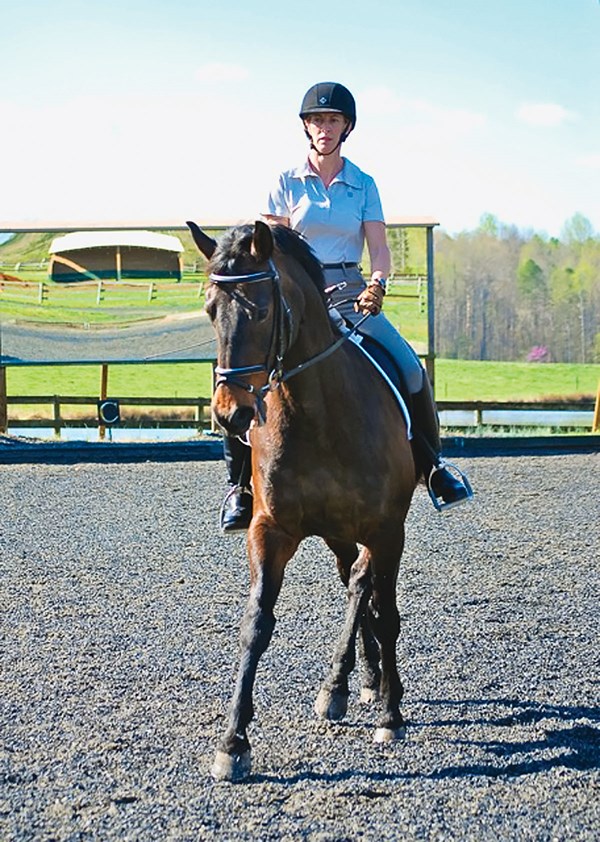This rider (Karen Allred on Anna) is a little bit crooked. Her body should be aiming toward the direction she and the horse are going in the half pass. Instead, her shoulders lean down to the outside, and her upper body aims to the outside. In addition, her outside hand is pulling toward the outside, whereas, I’d like to see it pushing the shoulders in the direction the horse is going. The whole left arm and hand are pulling to the left because the outside rein is trying to do the job of the inside leg.

Here is an exercise I suggest will help this rider: Ride a leg yield into the half pass. For instance, she can turn right down the centerline and leg yield to the left. Once she establishes the leg yield, she can ask for a few steps of half pass to the right, then resume leg yielding to the left. Every time she feels the horse come against her right leg, she leg yields to the left. At first, she may only half pass a few steps at a time, but this teaches two things: The rider’s right leg learns to make itself useful, and her horse learns to take the rider’s right leg seriously, thinking it really means “go sideways.” If the horse is truly off the rider’s inside leg, we’ll see the neck bulging out toward the outside rein instead of being convex.
The argument between the inside hand trying to bend the horse and the outside hand struggling to do the job of the inside leg is seen in the connection; the horse’s mouth is open, and the bit is being pulled out to the outside.
The rider’s fingers point down as if playing a piano. To point the knuckles down requires the forearm to twist, disrupting the straight line we’re trying to achieve. The thumb should sit on top of the rein to allow the hand to maintain a soft connection, while not allowing the reins to be pulled through the hand. Instead of being held in a tight a fist, the thumb can be firm on the rein and allow the fingers to remain soft.
The rider’s seat: Of course it’s hard to see from this angle, but judging by the shortened leg, the lack of hanging heel and the slightly forward upper body, I’d guess that she’s a little bit perched. It looks as if her butt cheeks might be a bit tight, making her seat rise slightly instead of hanging deep in the saddle.
To educate the rider’s body, I would have her walk around the ring on a loose rein and just practice letting everything relax and sink down. Then she could tighten her butt cheeks and feel what that does. Loose and tight—go back and forth a few times and feel the difference. I would also have her ride without stirrups and let her leg hang down, paying no attention to her heels.
I’m aware that this rider is only doing Second Level, so half passes are probably new to her. Something I firmly believe is that a little bit of good is better than a lot of not so good; three correct shoulder-ins are better than 17 incorrect ones and five correct ones. So focus on the details, making sure what you do is correct every time.











